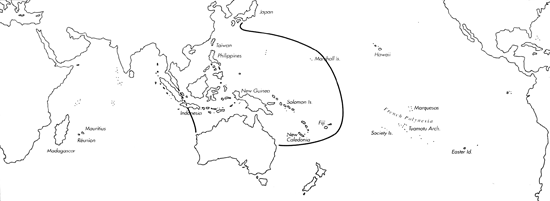
Skip Navigation Links
View access keys for this site.

Range: C. a. ammiralis: E. Thailand to N. W. Australia; Japan to Marshall Is., Fiji, New Caledonia to Queensland; C. a. pseudocedonulli: Mozambique to Kenya and Seychelles, a disjunct population in W. Thailand.
Description: Medium-sized to large, moderately solid to heavy; relative weight of similarly sized specimens may vary by 50%. Last whorl conical to ventricosely conical; outline variably convex at adapical fourth and almost straight below, sometimes slightly concave centrally. Shoulder angulate, smooth in C. a. ammiralis (Pl. 34, Figs. 1-7), except weakly tuberculate in specimens with granulose ribs on last whorl (form architalassus; Pl. 34, Fig. 6); shoulder prominently tuberculate in C. a. pseudocedonulli (Pl. 34, Figs. 8-11 ). Spire of low to moderate height, outline straight to concave. Maximum diameter of larval shell about 0.9 mm. About first 4 postnuclear whorls weakly tuberculate (C. a. ammiralis) or all whorls tuberculate (C. a. pseudocedonulli). Teleoconch sutural ramps flat to slightly concave, with 1 increasing to 4-6 fine spiral grooves, replaced by many spiral striae in last 3 whorls. Last whorl usually with closely spaced weak to obsolete spiral ribs near base; some populations of C. a. ammiralis (e.g. Moluccas; Solomon Is.) include granulose specimens (form architalassus).
| Shell Morphometry | ||
|---|---|---|
| L | - | |
| RW | - | |
| RD | - | |
| PMD | - | |
| RSH | - | |
Ground colour white. Last whorl with 2-6 variably broad pale orange to dark brown spiral bands, containing dark spiral as well as axial lines and interrupted by small to large white tents that may fuse to some extent. Below shoulder, at base and between colour bands, fine yellow to tan lines form a delicate network with fewer large white tents. Pattern occurs in varied designs. Larval whorls pink. Early postnuclear sutural ramps usually eroded, grading from pink to white, sometimes with brown dots at outer margins. Late ramps with light to dark brown radial blotches containing darker radial lines. Aperture white, occasionally orange-brown deep within.
Periostracum light brown, thin, translucent, and smooth.
Dorsum of foot white, mottled with brown and with a median black blotch at anterior end. Anterior edge of foot orange-red, posterior edge orange, sides black; black lateral bands across dorsum posteriorly. Sole of foot solid tan or white, mottled with brown; pedal mucus gland bordered by vermilion. Rostrum white grading to tan near tentacles; proboscis white, posteriorly yellow to orange-red anteriorly. Tentacles white, tipped with orange-red and with a black spot dorsally at base. Siphon white, orange-red distally, with a black band about 1/3 the length from the tip; proximal portion transversely mottled with brown, darker dorsally (Pearson, unpubl. observ.; Kohn, unpubl. observ.; Estival, unpubl. observ.).
Radular teeth with 2 adapical barbs and a long serration that ends in a cusp (Endean & Rudkin, 1965).
Habitat and Habits: C. a. ammiralis in 2-240 m, ranging as deep as 50-150 m in Queensland, 20-240 m in Philippines. Reported from fine to coarse sand and muddy sand, often beneath rocks and sometimes among algae. C. a. pseudocedonulli slightly subtidal to about 50 m, in similar habitats (da Motta, 1987; Grosch, pers. comm., 1989). C. ammiralis is molluscivorous, known to feed on Strombidae. It is preyed upon by C. marmoreus (Endean & Rudkin, 1965; Loch, pers. comm., 1987). Egg diameter of 331 ┬Ám suggests a minimum pelagic period of 12 days (Perron & Kohn, 1985).
Discussion: C. ammiralis is so distinctive that it cannot be confused with any of its congeners. We agree with Coomans et al. (1982) that C. pseudocedonulli is best considered a geographic subspecies of C. ammiralis, occurring throughout the Indian Ocean as far east as W. Thailand. Although Richard (1982, 1990) and da Motta and Lenavat (1979) recorded C. a. ammiralis from W. Thailand, da Motta later (1987: p. 28) noted that it does not occur there: "The nearest colony of ammiralis [to W. Thailand] is located off Songklha inside the Gulf of Thailand." Thus the Malayan Peninsula appears to be the distributional boundary between the two subspecies. C. a. temnes (Pl. 34, Fig. 3) is based on East Australian shells from deeper water that cannot be separated by any constant difference. C. architalassus (Pl. 34, Fig. 6) (synonyms are C. a. archithalassus and C. a. coronatus) refers to granulose specimens of C. a. ammiralis. The variability of C. ammiralis in colour pattern explains the long list of synonyms. C. hereditarius from W. Thailand agrees with C. a. pseudocedonulli from the W. Indian Ocean except for slightly smaller size. We therefore include this nominal species in C. a. pseudocedonulli.

C. ammiralis range map
This section contains verbatim reproductions of the accounts of 316 species of Conus from the Indo-Pacific region, from Manual of the Living Conidae, by R÷ckel, Korn and Kohn (1995). They are reproduced with the kind permission of the present publisher, Conchbooks.
All plates and figures referred to in the text are also in R÷ckel, Korn & Kohn, 1995. Manual of the Living Conidae Vol. 1: Indo-Pacific Region.
The range maps have been modified so that each species account has it own map, rather than one map that showed the ranges of several species in the original work. This was necessary because each species account is on a separate page on the website and not confined to the order of accounts in the book.
Return to framed version (returns to search page)